
The Distinguished Flying Cross (DFC) is a military decoration of the United States Armed Forces. The medal was established on July 2, 1926, and is currently awarded to any persons who, after April 6, 1917, distinguish themselves by single acts of heroism or extraordinary achievement while participating in aerial flight. Both heroism and extraordinary achievement are entirely distinctive, involving operations that are not routine. The medal may be awarded to friendly foreign military members in ranks equivalent to U.S. Pay Grade of O-6 and below, in actual combat in support operations.
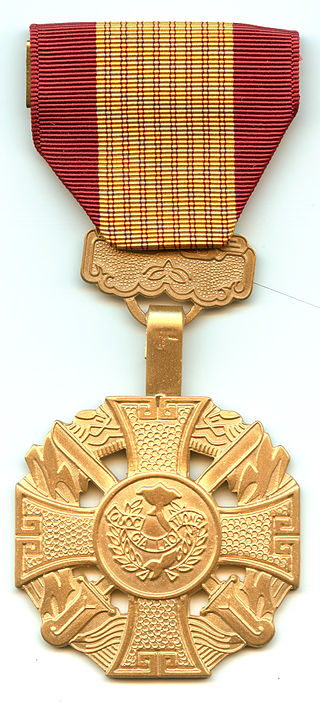
The Republic of Vietnam Gallantry Cross also known as the Vietnamese Gallantry Cross or Vietnam Cross of Gallantry is a military decoration of the former Government of South Vietnam. The medal was created on August 15, 1950, and was awarded to military personnel, civilians, and Armed Forces units and organizations in recognition of deeds of valor or heroic conduct while in combat with the enemy.

The Gold Lifesaving Medal and Silver Lifesaving Medal are U.S. decorations issued by the United States Coast Guard. The awards were established by Act of Congress, 20 June 1874; later authorized by 14 U.S.C. § 500. These decorations are two of the oldest medals in the United States and were originally established at the Department of Treasury as Lifesaving Medals First and Second Class. The Department of the Treasury initially gave the award, but today the United States Coast Guard awards it through the Department of Homeland Security. They are not classified as military decorations, and may be awarded to any person.
The World War I Victory Medal was a United States service medal designed by James Earle Fraser of New York City under the direction of the Commission of Fine Arts.
The Mexican Border Service Medal was a U.S. service medal established by an Act of Congress on July 9, 1918. It was awarded for service between May 9, 1916 and March 24, 1917, or with the Mexican Border Patrol between January 1, 1916 to April 6, 1917.
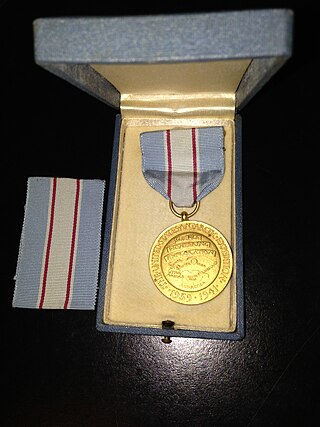
The United States Antarctic Expedition Medal is a combined military-civilian award that was authorized by the United States Congress on September 24, 1945 under Public Law 185 of the 79th Congress. The award recognizes members of the United States Antarctic Expedition of 1939–1941. There were gold, silver, and bronze versions. It is unclear if the gold version is considered a Congressional Gold Medal, as was the case with the 1st Byrd expedition.

The China Relief Expedition Medal was a decoration of the United States military which was issued to members of both the United States Navy and the United States Marines for service in the China Relief Expedition between 1900 and 1901 during the Boxer Rebellion. The medal was authorized by General Orders of the Department of the Navy on June 27, 1908. General Order 81 established the medal authorized for Naval personnel while General Order 82 authorized the medal for the Marine Corps.

The United States occupation of Veracruz began with the Battle of Veracruz and lasted for seven months. The incident came in the midst of poor diplomatic relations between Mexico and the United States, and was related to the ongoing Mexican Revolution.

The Meritorious Service Medal (MSM) is a military award presented to members of the United States Armed Forces who distinguished themselves by outstanding meritorious achievement or service to the United States subsequent to January 16, 1969.
The Haitian Campaign Medal was a United States Navy military award which was first established on June 22, 1917, and again on December 6, 1921.
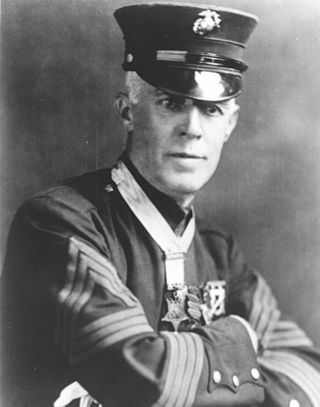
Henry Lewis Hulbert was a United States Marine who served during the Second Samoan Civil War and World War I. As a private, he received the Medal of Honor for distinguished service in Samoa on April 1, 1899.

Lytle Brown was a U.S. Army officer who fought in the Spanish–American War and participated in the Mexican Expedition of 1916. Brown served as Chief of Engineers from 1929 to 1933.

The United States involvement in the Mexican Revolution was varied and seemingly contradictory, first supporting and then repudiating Mexican regimes during the period 1910–1920. For both economic and political reasons, the U.S. government generally supported those who occupied the seats of power, but could withhold official recognition. The U.S. supported the regime of Porfirio Díaz after initially withholding recognition since he came to power by coup. In 1909, Díaz and U.S. President Taft met in Ciudad Juárez, across the border from El Paso, Texas. Prior to Woodrow Wilson's inauguration on March 4, 1913, the U.S. Government focused on just warning the Mexican military that decisive action from the U.S. military would take place if lives and property of U.S. nationals living in the country were endangered. President William Howard Taft sent more troops to the US-Mexico border but did not allow them to intervene directly in the conflict, a move which Congress opposed. Twice during the Revolution, the U.S. sent troops into Mexico, to occupy Veracruz in 1914 and to northern Mexico in 1916 in a failed attempt to capture Pancho Villa. U.S. foreign policy toward Latin America was to assume the region was the sphere of influence of the U.S., articulated in the Monroe Doctrine. However the U.S. role in the Mexican Revolution has been exaggerated. It did not directly intervene in the Mexican Revolution in a sustained manner.
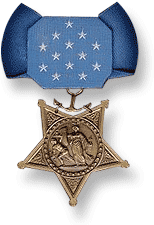
Lieutenant Commander John McCloy, USN was an officer in the United States Navy who was one of only 19 individuals to receive the Medal of Honor twice. He received his first Medal of Honor for action in the Boxer Rebellion in June 1900. His second Medal of Honor came in 1915 for action in Vera Cruz, Mexico in April 1914.

Major General Logan Feland was a United States Marine Corps general who last served as commanding general of the Department of the Pacific. Feland served during the Spanish–American War, the occupation of Veracruz (1914) and in World War I, where he was in command of all troops during the Battle of Belleau Wood.

Mark Leslie Hersey was a major general in the United States Army who commanded the 4th Division during World War I.
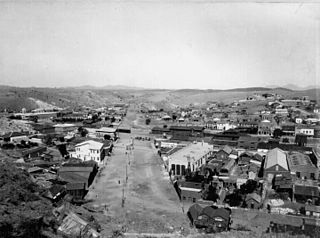
The Battle of Ambos Nogales, or as it is known in Mexico La batalla del 27 de agosto, was an engagement fought on 27 August 1918 between Mexican military and civilian militia forces and elements of U.S. Army troops of the 35th Infantry Regiment, who were reinforced by the Buffalo Soldiers of the 10th Cavalry Regiment, and commanded by Lt. Col. Frederick J. Herman. The American soldiers and militia forces were stationed in Nogales, Arizona, and the Mexican soldiers and armed Mexican militia were in Nogales, Sonora. This battle was notable for being a significant confrontation between U.S. and Mexican forces during the Border War, which took place in the context of the Mexican Revolution and the First World War.

The Mexican Border War, or the Border Campaign, refers to the military engagements which took place in the Mexican–American border region of North America during the Mexican Revolution. The period of the war encompassed World War I, and the German Empire attempted to have Mexico attack the United States, as well as engaging in hostilities against American forces there itself.

Colonel Frank Tompkins was an officer in the United States Army. Tompkins served in numerous conflicts including the Spanish–American War in Cuba, the Philippine–American War, the Mexican Border War, and World War I. Recommended by General John J. Pershing for the Medal of Honor, he was awarded the Distinguished Service Cross for his leadership during the 1916 Battle of Columbus, New Mexico.

With the end of World War I in 1918, the Air Service, United States Army was largely demobilized. During the demobilization period of 1919, the Regular Army and its air arm answered a call to defend the southern border against raids from Mexico, and to halt smuggling of illegal aliens and narcotics into the United States and weapons from the United States into Mexico.

















